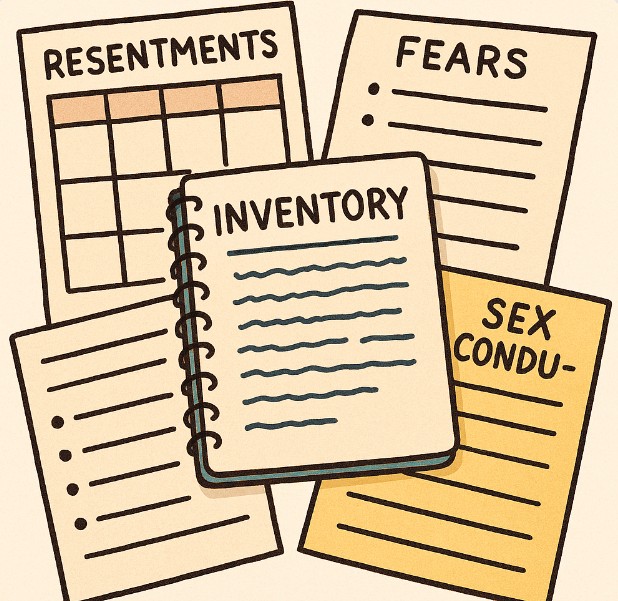- 28 November 2022
- 3247 views
Search

Uncovering the patterns that keep us stuck—and how to break free
Most people dread Step 4. I love it. In this post, I’ll share why inventory is the turning point in recovery—and how you can make it work for you, no matter your format or fears. This step is foundational for the next few posts in this series, and while it may not be the most popular, it’s one of the most powerful.
Why We Do Inventory
The point of doing an inventory is to uncover our self-will and clearly see the negative impact it has on our lives. It’s an honest look at our attitudes and behaviors—not an opportunity to shame or blame ourselves. Once we can identify the thoughts, attitudes, and behaviors that put us in conflict with people and the world around us, we gain the ability to make meaningful changes.
As the Big Book says:
“Next we launched out on a course of vigorous action, the first step of which is a personal housecleaning, which many of us had never attempted. Though our decision was vital and crucial step, it could have little permanent effect unless at once followed by a strenuous effort to face, and to be rid of, the things in ourselves which had been blocking us. Our liquor was but a symptom. So we had to get down to causes and conditions.” (Alcoholics Anonymous, pp. 63–64)
Notice the urgency: “Next” and “at once.” This is not a casual suggestion—it’s a call to action.
What These Words Really Mean
Let’s break down a few key terms from that passage:
- Launched – to start or set in motion
- Vigorous – involving physical strength, effort, or energy
- Strenuous – requiring or using great exertion
This isn’t meant to be easy. It’s meant to be transformative.
My First Inventory Experience
I’ve seen many people start writing their inventories only to find the task overwhelming. They lose momentum and stop. Sadly, it doesn’t take long for them to start abusing food again.
My first sponsor, TS, had me work through the questions in The Twelve Steps and Twelve Traditions of Overeaters Anonymous (nicknamed the OA 12&12). There were about 105 questions, and she encouraged me to answer all of them. I started writing my answers, but around question 20, I “couldn’t find the time.” Procrastination crept in.
After three weeks of no progress, TS gently told me she was concerned I’d relapse if I didn’t finish. I took her seriously and booked time with her to share my inventory two weeks later. That deadline helped me push through. I wasn’t completely finished, but I was close. It turns out that giving away 105 long answers takes time—I shared half one week and finished the rest before our next appointment.
A Simpler, Sustainable Format
A few months later, I worked with LC, who taught me how to do an inventory following the instructions in the Big Book. I found this format simple, to the point, and sustainable. My first experience with the OA 12&12 was eye-opening and effective, but I knew I wouldn’t likely answer all those questions again.
The Big Book outlines three inventories:
- Resentments
- Fears
- Sex Conduct
There are many free forms available online—some printable, some fillable. My favorites are found on:
Inventory Formats That Work
I tend to lose printed sheets, so now I use a coil-bound notebook. One of the people I sponsor uses the OA Big Book sheets but doesn’t follow the columns. Her writing is upside down and sideways—sometimes 10 resentments on one page. She has long-term recovery.
Another woman I sponsor uses a format where defects are listed on one side and assets on the other. She likes the visual goal. She also has long-term recovery.
The takeaway? Recovery isn’t in the format. It’s in the willingness to see the negative patterns and face the stuff that sends us back to food.
Getting Started: Tools & Tips
Over the next few posts, I’ll walk through each column using a notebook and share pictures of the progression so you’ll have a concrete example to follow. For now, here’s how to get started:
- Visit one of the sites above and download the sheets, or get a coil-bound notebook (I use 8½ x 11 because I print big).
- Grab some good pens or pencils. A ruler is optional.
- Set a time and place where you won’t be interrupted. I schedule 15–30 minutes per session.
Blast off. You’ve got this.



Leave Comment